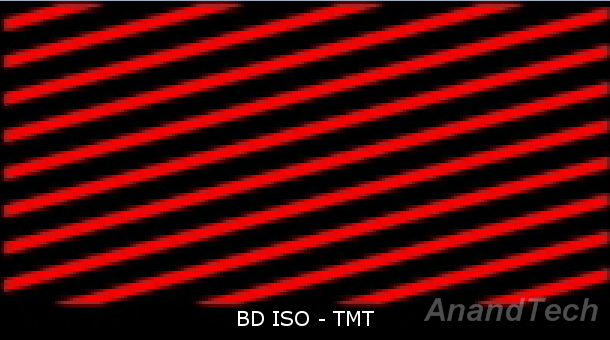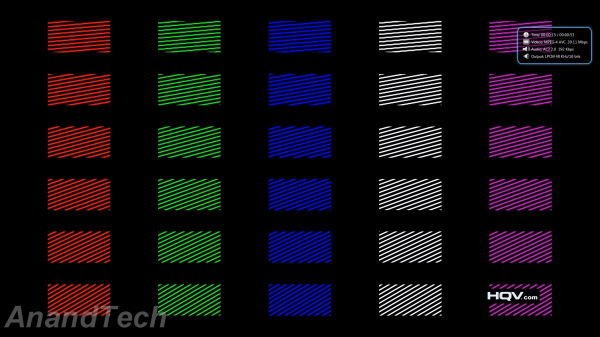AMD Radeon HD 7750 & Radeon HD 7770 GHz Edition Review: Evading The Price/Performance Curve
by Ryan Smith & Ganesh T S on February 15, 2012 12:01 AM EST- Posted in
- GPUs
- AMD
- HTPC
- GCN
- Radeon HD 7000
HQV 2.0 Benchmarking
HTPC enthusiasts are often concerned about the quality of pictures output by the system. While this is a very subjective metric, we have decided to take as much of an objective approach as possible. Over the last year or so, we have been using the HQV 2.0 benchmark for this purpose.
The HQV 2.0 test suite consists of 39 different streams divided into 4 different classes. The playback device is assigned scores for each, depending on how well it plays the stream. Each test was repeated multiple times to ensure that the correct score was assigned. The scoring details are available in the testing guide on the HQV website.
We first played back the benchmarking clips off the Blu-ray, but the scores recorded below are for standalone M2TS playback using CyberLink PowerDVD 12. Our take is that it is standalone files (such as those taken using consumer camcorders and smartphones) which require video post processing more than the already carefully transferred Blu-ray content. If certain driver post processing features are available only for Blu-ray playback, then, it is as good as not being available for consumers to take advantage.
In the table below, we indicate the maximum score possible for each test, and how much the 7750 was able to get with AMD's Catalyst 12.1-based launch drivers.
| AMD 7750 : HQV 2.0 Benchmark | ||||
| Test Class | Chapter | Tests | Max. Score | Radeon HD 7750 |
| Video Conversion | Video Resolution | Dial | 5 | 5 |
| Dial with Static Pattern | 5 | 5 | ||
| Gray Bars | 5 | 5 | ||
| Violin | 5 | 5 | ||
| Film Resolution | Stadium 2:2 | 5 | 5 | |
| Stadium 3:2 | 5 | 5 | ||
| Overlay On Film | Horizontal Text Scroll | 5 | 5 | |
| Vertical Text Scroll | 5 | 5 | ||
| Cadence Response Time | Transition to 3:2 Lock | 5 | 5 | |
| Transition to 2:2 Lock | 5 | 5 | ||
| Multi-Cadence | 2:2:2:4 24 FPS DVCam Video | 5 | 5 | |
| 2:3:3:2 24 FPS DVCam Video | 5 | 5 | ||
| 3:2:3:2:2 24 FPS Vari-Speed | 5 | 5 | ||
| 5:5 12 FPS Animation | 5 | 5 | ||
| 6:4 12 FPS Animation | 5 | 5 | ||
| 8:7 8 FPS Animation | 5 | 5 | ||
| Color Upsampling Errors | Interlace Chroma Problem (ICP) | 5 | 2 | |
| Chroma Upsampling Error (CUE) | 5 | 2 | ||
| Noise and Artifact Reduction | Random Noise | SailBoat | 5 | 5 |
| Flower | 5 | 5 | ||
| Sunrise | 5 | 5 | ||
| Harbour Night | 5 | 5 | ||
| Compression Artifacts | Scrolling Text | 5 | 5 | |
| Roller Coaster | 5 | 5 | ||
| Ferris Wheel | 5 | 5 | ||
| Bridge Traffic | 5 | 5 | ||
| Upscaled Compression Artifacts | Text Pattern | 5 | 3 | |
| Roller Coaster | 5 | 3 | ||
| Ferris Wheel | 5 | 3 | ||
| Bridge Traffic | 5 | 3 | ||
| Image Scaling and Enhancements | Scaling and Filtering | Luminance Frequency Bands | 5 | 5 |
| Chrominance Frequency Bands | 5 | 5 | ||
| Vanishing Text | 5 | 5 | ||
| Resolution Enhancement | Brook, Mountain, Flower, Hair, Wood | 15 | 15 | |
| Video Conversion | Contrast Enhancement | Theme Park | 5 | 5 |
| Driftwood | 5 | 5 | ||
| Beach at Dusk | 5 | 5 | ||
| White and Black Cats | 5 | 5 | ||
| Skin Tone Correction | Skin Tones | 10 | 7 | |
| Total Score | 210 | 193 | ||
We were not able to match what AMD claimed. In all probability, the difference is in the chroma upsampling scores. We already covered this in the Llano review. To recap, the image below is a screen capture while playing the HQV benchmark clip from a Blu-ray ISO on the AMD A8-3850. Note that the light red fringes along the edgs are uniform and extend to the right and the left before tapering off.

Now, let us look at the screen capture when the M2TS is played back using PowerDVD 12 on the Radeon HD 7750.
Zoom into the red stripes on the third row (in the original screenshot) and you can see for yourself that we have some ghost samples extending above and below the actual line of pixels. The screenshot is not at the exact timestamp as that of the Llano sample reproduced above, but the reader should be able to get a general idea of the problem we are hinting at. Readers interested in finding out more about the source of this problem should read up this excellent piece to get more information.
We notified AMD about this issue during the Llano review, but action doesn't seem to have been taken even after 6 months on what is clearly a driver issue. Note that we are not using MPC-HC (which might introduce its own errors in the renderer) in this case, but a standard off-the-shelf commercial player in CyberLink PowerDVD 12. Hopefully, AMD wakes up to this issue soon.











155 Comments
View All Comments
kallogan - Wednesday, February 15, 2012 - link
HD 6850 is still the way to go.zepi - Wednesday, February 15, 2012 - link
So basically in couple of generations we've gone4870 > 5770/6770 > 7770
Chip size
260mm2 > 165mm2 > ~120mm2 chip.
Performance is about
100 > 100 > 120
Power consumption in gaming load according to Techpowerup (just graphics card):
150W - 108W - 83W
And soon we should have 1 inch thick laptops with these things inside. I'm not complaining.
silverblue - Wednesday, February 15, 2012 - link
Good point. One thing I think people forget is that smaller processing technologies will yield either better performance at the same power, or reduced consumption at the same performance... or a mix of the two. You could throw two cards in dual-GPU config for similar power to one you had two years back, and still not have to worry too much if CrossFire or SLi doesn't work properly (well, if you forget the microstuttering, of course).cactusdog - Wednesday, February 15, 2012 - link
WHy is the 6770 left out of benchmarks?? Isnt that odd considering the 7770 replaces the 6770? I really wish reviewers would be independant when reviewing cards, instead of following manufacturer guidelines.Markstar - Wednesday, February 15, 2012 - link
No, since the 6770 is EXACTLY the same card as the 5770 (just relabeled). So it makes sense to continue using the 5770 and remind AMD (and us) that we do not fall for their shenanigans (sadly, many do fall for it).gnorgel - Wednesday, February 15, 2012 - link
For your 6850. It should sell a lot better now. Maybe they really stopped producing it and need to get rid of stocks. But when it's sold out almost anyone should go for a gtx 560, 7% more expensive and 30% faster.The only reason to buy a 7770 now is if your powersupply can't support it and you would have to get a new one.
duploxxx - Wednesday, February 15, 2012 - link
by the time the 6850 is out of stock the 78xx series are launched which will knock out 560don't understand what evryone is complaining about, its faster then the 57xx-67xx series, les spower. sure it's not cheap but neither are the 57-67 @ launch. Combined with old gen available and NV products a bit to expensive but this is just starting price....
akbo - Wednesday, February 15, 2012 - link
Moore's law apparently doesn't apply to graphic cards. People expectations do. People expect that every two years gpus at the same price point have double transistors and thus be faster by so. Obviously perf does not scale like so since the 28 nm shrink only has a 50% improvement from 40 nm. However that would mean a 50% improvement is expected. Imperfect scaling would mean a 40% improvement.So people expect that a card which is 20% faster than a card from 2 years ago to be 1.2/1.4 the price at launch, or an ~ 85% of the 5770 launch price in this case. That would mean that the card should retail at around $130-140 or so for the 7750 and sub-$100 pricing, like $90 or so. I expect it to be that price too.
chizow - Wednesday, February 15, 2012 - link
Moore's Law does actually hold true for GPUs in the direct context of the original law as you stated, roughly doubled transistors every 2 years with a new process node. The performance has deviated however for some time now with imperfect scaling relative to transistors, but at least ~50% has been the benchmark for performance improvements over previous generations.Tahiti and the rest of Southern Islands itself isn't that much of a disappointment relative to Moore's Law, because it does offer 40-50% improvement over AMD's previous flagship GPU. The problem is, it only offers 15-25% improvement over the overall last-gen performance leader the GTX 580 but somewhat comically, AMD wants to price it in that light.
So we end up with this situation, the worst price performance metrics ever where a new GPU architecture and process node only offers 15-25% performance increase at the same price (actually 10% more in the 7970 case). This falls far short of the expectations of even low-end Moore's Law observer estimates that would expect to see at least +50% over the last-gen overall high-end in order to command that top pricing spot.
arjuna1 - Wednesday, February 15, 2012 - link
DX11.1?? With only one true DX11 game on the market, BF3, there is literally no incentive to upgrade to this generation of cards 7xxx/kepler.Unless nvidia comes out with something big, and I mean big as in out of this world, I'll just skip to the next gen, and if AMD insists in being an ass with pricing, I'll go Ngreen when the time comes.
Now, the worrying thing is that it's becoming evident, both parties are becoming too cynical with price fixing, when is that anti trust lawsuit coming?